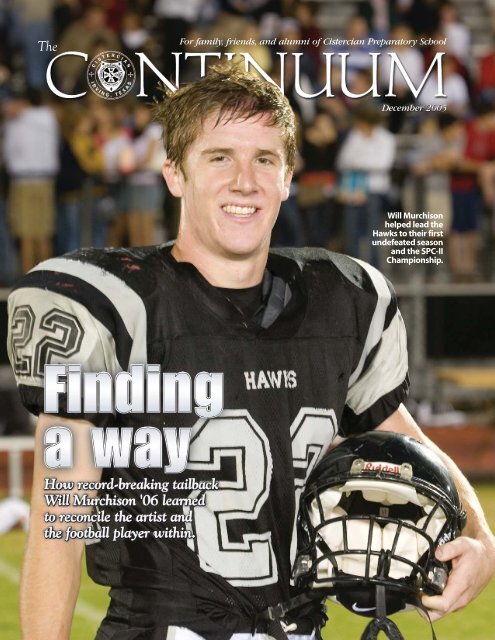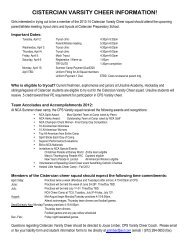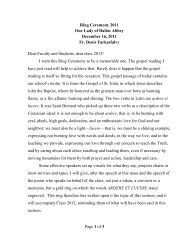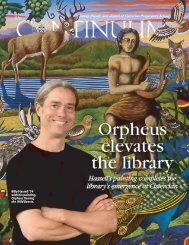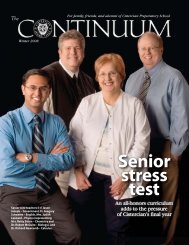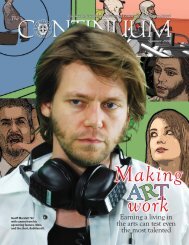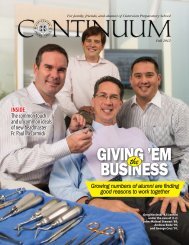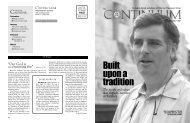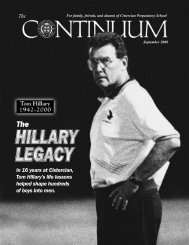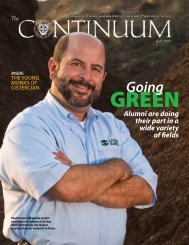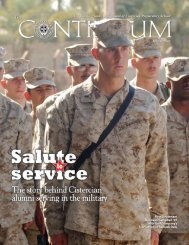December 2005: "Finding a Way" - Cistercian Preparatory School
December 2005: "Finding a Way" - Cistercian Preparatory School
December 2005: "Finding a Way" - Cistercian Preparatory School
- No tags were found...
You also want an ePaper? Increase the reach of your titles
YUMPU automatically turns print PDFs into web optimized ePapers that Google loves.
TheFor family, friends, and alumni of <strong>Cistercian</strong> <strong>Preparatory</strong> <strong>School</strong><strong>December</strong> June <strong>2005</strong>Will Murchisonhelped lead theHawks to their firstundefeated seasonand the SPC-IIChampionship.
The Memorare Society was established for members of our communitywho wish to include <strong>Cistercian</strong> in their financial plans throughbequests, trusts, wills, or other means. It’s a wonderful way for peopleto include the school as part of their long-term financial planning.As a member of the Memorare Society, you’ll enable us to continueeducating <strong>Cistercian</strong> students and the Abbey’s young monksfor many years. All while ensuring your legacy with <strong>Cistercian</strong> forgenerations to come. After all, Memorare means “remember.”To find out if the Memorare Society is right for you and your family,simply contact Jennifer Rotter in the Development Office today.All enquiries are welcome. Call 469-499-5406, or send an emailto jrotter@cistercian.org.2 The CONTINUUM
CISTERCIANPREPARATORYSCHOOLRev. Peter Verhalen ’73HeadmasterRev. Bernard MartonAssistant Headmaster,College CounselorGreg Novinski ’82Dean of StudentsRobert J. HaaserDirector of AdmissionsChristine MedailleDirector of StudiesJennifer RotterDirector of Developmentand Alumni RelationsDan LeeDirector of AthleticsOscar Arras ’78President, <strong>Cistercian</strong>Alumni Association<strong>School</strong> BoardRt. Rev. Denis FarkasfalvyRev. Julius LeloczkyRev. Robert MaguireRev. Bernard MartonRev. Benedict MonostoriRev. Peter Verhalen ’73David C. HaleyJames J. HartnettDr. Robert J. HendersonJames M. Moroney III ’74Peter P. Smith ’74Jere W.Thompson, Jr. ’74The CONTINUUMDavid Stewart ’74Editor & Art DirectorTom B. PruitCopy EditorSally L.CookAssistant Copy EditorJim ReischPhotography EditorThe CONTINUUM ispublished three times a year(<strong>December</strong>, March, and June) by<strong>Cistercian</strong> <strong>Preparatory</strong> <strong>School</strong>.3660 <strong>Cistercian</strong> RoadIrving,TX 75039469-499-5400www.cistercian.orgReflecting on our many blessingsSuccesses from 50 years ago and from just last month give us pauseThis issue of The Continuum offers news of manysuccesses. As always, the Class Notes sectionincludes the “successes” of alumni who introduce theirnewborns to the community and who announce jobpromotions. The News andSports sections bring you storiesof student, faculty, andalumni successes. But all ofthese represent only a smallfraction of the successes of the<strong>Cistercian</strong> Community atlarge. Many we don’t hearabout. Others we haven’t thespace to publish. But, we areLetter fromthe HeadmasterFr. PeterVerhalen ’73volume 33, number 1<strong>Finding</strong>a way 12In Upper <strong>School</strong>,Will Murchison ’06learned about theartist in the footballplayer, or vice versa.grateful for every blessing thecommunity receives, publicizedor not.In our first feature, DavidStewart ’74 tells the fascinatingstory of how the <strong>Cistercian</strong> fathers succeeded infinding a home in America. These courageous prieststhought nothing of escaping Hungary, leaving behind,as they used to say, everything but their accents. Theywere determined to preserve their traditions in astrange land, with a very different language and culture.While they probably did not think of themselvesas a great success story in 1955, we know today, 50years later, that they indeed established a wellspring ofsuccesses: the <strong>Cistercian</strong> Abbey and <strong>School</strong>.In his second story, David captures a story of onesenior’s journey through Upper <strong>School</strong>; it representsthe process every student undergoes as he exploreshis own talents and feelings. This year, WillMurchison ’06 ran his way into <strong>Cistercian</strong> footballhistory while he added to his award-winning artportfolio. His leadership qualities were forgedthrough facing the challenges of adolescence —learning who he was so he could put himself at theservice of the class, the team, and the community.The story also portrays the efforts of the <strong>Cistercian</strong>faculty, staff, and parents to support and guide Will.Through such efforts we hope to help every studentpursue his interests and talents while always thinkingfirst of the other.I hope the stories in this issue encourage you toreflect on the many blessings <strong>Cistercian</strong> has enjoyedover the last 50 years. This Christmas let us all —students, faculty, monks, alumni, and parents —pray that we might bring the hope and blessing thatis Christ into our own communities.in this issueUnlikelyTexans 6Hungarian <strong>Cistercian</strong>scame to America afterWW II to preserve theirway of life. <strong>Finding</strong> ahome in the New Worldwouldn’t be easy.departments<strong>School</strong> News . . . . . . . . . . . . . . . . . . . . . . 4Sports News . . . . . . . . . . . . . . . . . . . . . 17Class Notes . . . . . . . . . . . . . . . . . . . . . 18On Prayer by Fr. Roch Kereszty . . . . . . . 23Afterthoughts by Smokey Briggs . . . . . . 24Calendar . . . . . . . . . . . . . . . . . . . . . . . . 24Cover photography: Jim Reisch<strong>Cistercian</strong> <strong>Preparatory</strong> <strong>School</strong> was founded with the aim of preparing talented boys for the colleges of their choice bychallenging their minds with excellent academic programs, molding their character through the values of Catholiceducation, and offering them guidance with both understanding and discipline. <strong>Cistercian</strong> <strong>Preparatory</strong> <strong>School</strong> does notdiscriminate on the basis of race, color, national or ethnic origin in the administration of its educational practices, admissions,scholarship programs, and athletic and other school administered programs.<strong>December</strong> <strong>2005</strong> 3
English Lab (Form III), alsoteaches at SMU Law <strong>School</strong>.She earned her law degree fromthe University of Texas <strong>School</strong>of Law.“As a parent and as ateacher,” said Heard, mother ofZach Heard ’05 and ConnorHeard ’08, “I have seen firsthand the mysterious quality ofan all-boy education.<strong>Cistercian</strong> is confident enoughin itself to allow the boys to takerisks and find their way.”Jeff Breeding, who has aB.A. in Kinesiology and aminor in science from theUniversity of Texas atArlington, is familiar to manyboys in the Upper <strong>School</strong> fromhis coaching stint at <strong>Cistercian</strong>two years ago. The Dallasnative and Richardson High<strong>School</strong> graduate who playedcollege baseball teaches Health(Form III), PE (Forms I and II)and serves as the head coach forJV football.“I believe that <strong>Cistercian</strong> isspecial,” Breeding said,“because of how the faculty andstaff work together to benefitthe students.”Andrew Gregg ’01, graduatedfrom the University of theSouth just this last May, with adouble major in Latin andMediaeval Studies, along with aminor in Ancient Greek. Greggteaches Latin (Form III).“I am frequently surprised,or awed, by the ‘genius’[here],”he said.“It’s a kind of group projectwe’re all working on,” he added,“defining the <strong>Cistercian</strong> genius,or ‘<strong>Cistercian</strong>-ness,’ and what itmeans to be a great <strong>Cistercian</strong>student, teacher, or friend, in asmany ways as possible.”Katie AwardsReisch andRogers win PressClub honorsWhile <strong>Cistercian</strong> may not bea bastion of journalism education,a couple of members of thecommunity earned recognitionat the 47th Annual KatieAwards, presented by the PressClub of Dallas in November.Tim Rogers ’88 won a Katiefor Best Writing Portfolio in themagazine category for his workin D Magazine, where he isexecutive editor. This is Rogers’third Katie.Jim Reisch, commercial photographer,<strong>Cistercian</strong> teacher, andparent won a Katie in the VisualCommunications category forBest Photography Portfolio forPhoto by Jim Reischcistercian newsKATIE WINNERS Jim Reisch andTim Rogers ’88 with their awards.his work in the UTD <strong>School</strong> ofManagement magazine.The Dallas Morning News,under the steady hand of JimMoroney ’74, won seven Katies.Reports from Katrina countryAlumni in New Orleans and Mississippi swap storiesWhen Kyle Resh ’99 woke up to thenews that Katrina had morphed into aCategory 5, he had only two hours to getout of town.“I grabbed clothes to last a few days,”he said. He and his girlfriend, plus hisbest buddy and roommate hit the roadbefore noon on Sunday.They would not return for two months.It was much the same story for RodKATRINA’S WRATH Pat Haggerty ‘86 laughsabout damage to his property (above) butfeels lucky his loved ones escaped harm.Walter ’83 whose house in New Orleanssuffered significant damage. He and hisfamily just recently moved back.Bryant Konermann ’96, who ownsJimmy’s Music Club not far from TulaneUniversity, also came back after a coupleof months away.“If it wasn’t flooded, it was looted,”he reported.But federal troops and local cops aredoing their best.Photo by Patrick Haggerty“I recently called in arobbery and 15 troops, 20cops, and two search dogsshowed up.”Fifty percent of thecity remains withoutpower and land lines arestill down.“But ‘Help Wanted’signs are everywhere,” hesaid, “If you can work ahammer, you get a job.”Both Resh andKonermann have adopteda wait-and-see attitudeabout the future of theCrescent City.“We were lucky,” Mike Novinski ’90reported from Columbia, Mississippi(about 90 miles north of the Gulf). “Notrees close to the house, and the windwent the other way on us.”Just north of Pascagoula, which isabout 15 miles from the Gulf, PatHaggerty ’85 knew that “when aCategory 4 Hurricane hits, you know it’sall toast.”Actually, Haggerty’s house sufferedno structural damage, but “some of theroof was taken down to plywood. We didloose a barn though.”His former beach house (he was rentingit out at the time) was not so lucky.“Everything under five feet is seethrough,no brick, no doors, no windows,”he explained.“Yea, I had one sleepless night justafter it came in,” Haggerty admitted.“On the day after the storm, my wife,who’d been staying safe with familywhile I was teaching in New Jersey,packed up the Ford F-350 with all thediesel and water she could carry, alongwith the greyhound, my 12-year-old fosterdaughter, and her .45 and drove backinto the black hole that was southernMississippi.“It was two days before I heard fromher again.“Talk about sleepless nights.”“You think you’d miss the house, orthe car, or the barn?”“Cry to someone else, I feel lucky.”<strong>December</strong> <strong>2005</strong> 5
Editor’s note: In the spring of 1955, seven <strong>Cistercian</strong> Fathers movedinto a residence on Swiss Avenue. Two years later, constructionbegan on the first wing of the current monastery, which wasconsecrated in 1958. The following story, one of a number ofhistorical perspectives we’ll bring you over the next few years, isdedicated to the pioneers whose efforts 50 years ago madepossible the <strong>Cistercian</strong> Abbey and Prep <strong>School</strong> we know today.LORD,” SHIVERED FR. BENEDICTMonostori as he lifted his clothes onto the bankand climbed naked from a five-foot-deep irrigation“GOODcanal. Along with 19 <strong>Cistercian</strong> student monks andanother <strong>Cistercian</strong> priest, he had escaped only minutes before acrossthe 50-yard-wide Hungarian border, replete with guard towers,barbed wire, and minefields.Now they stood shaking silently as they dried themselves, tryingto steel themselves against the cold and the uncertainty that layahead. A couple of hours remained before dawn. For a moment, FrBenedict’s gaze was drawn back towards Hungary.“Never again in our lives will we return to our homeland,” hethought. Then he turned back towards Austria. There wasn’t time forreminiscing.Peering into the chilly darkness, Fr. Benedict slowly shook hishead, “I don’t even know where we are going.”6Only 13 of the 21 would make it to Vienna and eventually to Stamsand Rome. Eight were arrested on a bus en route to Vienna, returned toHungary, and imprisoned (including Fr. Pascal Kis-Horvath).Nearly eight weeks later, on October 29, Abbot WendelinEndrédy, the abbot of Zirc, was arrested and imprisoned. TheSoviets were slamming the door on the <strong>Cistercian</strong> Order in Hungary.No more <strong>Cistercian</strong>s would manage to escape the country againuntil the Revolution of October 1956.But prior to his arrest, Abbot Wendelin had helped dozens of<strong>Cistercian</strong>s from the Abbey of Zirc (the mother abbey of allHungarian <strong>Cistercian</strong>s, pronounced ZEERTS) escape. They wouldkeep the traditions of the Abbey living and breathing in America.The idea of going to America had been proposed by a 29-year-oldpriest living in Eger, Hungary in the summer of 1945. A brilliant manof many passions, Fr. Louis J. Lekai was repulsed by the idea of aSoviet occupation. While many expected the Soviets to abandonARRIVING SAFELY IN STAMS In September 1950, Fr. BenedictMonostori and 12 student monks arrived at the <strong>Cistercian</strong> Abbey ofStams, in Tirol, Austria shortly after their escape from Hungary.Five ended up in Dallas, Br. Daniel Csanyi (far left), Br. MelchiorChladek, Fr. Benedict, Br. Aloysius Kimencz, (the sixth, seventh andeighth from the left), and Br. David Balas (second from the right).The second priest in the photo is thier host, the prior of Stams.The CONTINUUM
Hungary by 1947, Fr. Louis believed they had more sinister plans.“We must look forward,” he wrote to friend and former <strong>Cistercian</strong>classmate Fr. Anselm Nagy on July 19, 1945, “and do our best withwhat is left of our lives. We must work and begin to make plans. Formy part, I have formed a plan which I have already communicatedto our abbot.”Establishing a foundation in America appeared to him to be theonly certain way to preserve their way of life.“I do not want to exaggerate,” he concluded his letter to Fr.Anselm, “but one may say that the survival of our communitydepends on our readiness to work with dedication and diligence forwhat we set out as our goal.”That plan – to build a school and a monastery in the New World –was approved by Abbot Wendelin in a surprisingly swift fashion. (TheAbbey of Zirc had developed a distinctly Hungarian identity, one thatset it apart from the rest of the <strong>Cistercian</strong> Order and made it seem anunlikely candidate for a move to the New World.)This decisive and unprecedented move would preserve thelegacy of Zirc, even while the doors of the Abbey itself remainedclosed to religious activity for 45 years.Between 1946 and 1968, atotal of 42 <strong>Cistercian</strong>s from theAbbey of Zirc would land safelyin the US (although 10 eventuallyleft the Order).The first of those priests fromZirc, the pioneers who arrived inAmerica between 1946 and1954, faced a complex set ofproblems before they couldestablish the monastery they hadenvisioned.FR. LOUIS, WHO WOULDawe history students at theUniversity of Dallas years later,had been pushing for anAmerican foundation since1945. He was still pushing in thesummer of 1953.Fr. Louis and Fr. Anselmembarked together on severalexploratory expeditions to find apermanent home. Thier first, inAugust 1949, took them to 19western and southwestern diocesesduring a three-week period.Fr. Louis served as the pitchman, touting the <strong>Cistercian</strong>s’skills with gusto, while Fr.Anselm listened politely, carefullytook notes, and analyzedthe prospects.But diocesan officials whomet with Fr. Louis and Fr.Anselm could be forgiven ifthey had some reservationsabout these <strong>Cistercian</strong>s fromHungary.Heavy accents, mispronouncedwords, and still-developinggrammar shrouded themeaning of their sentences.The playersBringing Zirc to AmericaAbbot Wendelin Endrédy (1895-1981) The Abbot of Zircwould preside over the final “glory years” of the <strong>Cistercian</strong>sin Hungary. A near saintly figure, his decisive actions wouldpreserve the legacy of Zirc by helping monks and studentmonks leave Hungary to establish a foundation in America.Arrested in October 1950, he was tortured and held in solitaryconfinement in miserable conditions for six years. “Asa result of all these experiences,” he said, “my life wasenriched immeasurably. I feel no anger against any personwho tortured me.”Fr. Louis Lekai (1916-1994) He initiated the 1945 plan to createan American “branch” of the Abbey of Zirc. Upon hisarrival in America in 1949, he tirelessly and passionatelyscoured the states in search of the right home for theHungarians. A world-class historian, he would teach historyat the University of Dallas from 1956 to 1981, when he suffereda debilitating stroke.Fr. Anselm Nagy (1915-1988) Abbot Wendelin sent Fr.Anselm to America in 1946 to investigate the possibilitiesfor a foundation. A methodical mathematician, Fr. Anselmwould serve as a steadying influence on the often passionateand independent-minded monks from Zirc. His tireless fundraisingand conservative financial management would helpthe community build the monastery and school with virtuallyno debt.Abbot General Sighard Kleiner (1904-1995) The youngAbbot General, who was elected in 1953, hoped to reformthe <strong>Cistercian</strong>s into a more contemplative monastic order.These attempts would fail. While he would have his differenceswith the Hungarians, he would eventually supporttheir new community in Texas.While Fr. Louis attempted to extol their Hungarian teaching experienceand advanced degrees, his listeners must have wondered howAmerican secondary school students could learn anything fromthese Hungarians if they could not understand them.(Even decades later, parents of students at <strong>Cistercian</strong> Prep <strong>School</strong>would have a devil of a time deciphering the homilies delivered byFr. Anselm at Opening and Closing Ceremonies.)“The mastering of the new language proved to be far more difficultand required a far longer time than had been anticipated,” Fr.Louis acknowledged in a 1968 article published in The Records ofthe American Catholic Historical Society.That first trip in 1949, however, generated offers from both SanDiego and Dallas. Fr. Louis spent four months in San Diego beforeconcluding that the venture — to create a prep school in conjunctionwith the planned University of San Diego — posed too many financialrisks. (The Dallas offer was not pursued at this time; perhaps theTexas heat scared them away.)Despite the language difficulties, the <strong>Cistercian</strong>s clearly communicatedtheir pride – even their arrogance – about their Hungarianlineage and their affiliation with the Abbey of Zirc.“[Hungarian is] a languagethat lacks resemblance to allmajor idioms of the world andconveys upon its native speakersa sense of both isolation and singularity,”explained AbbotDenis Farkasfalvy in his 1998account of the founding of the<strong>Cistercian</strong> Monastery in Dallasin <strong>Cistercian</strong>s in Texas.This “singularity” is capturedin an old saying. Hungarians liketo quote it in Latin as if it werean internationally knownproverb: “Extra Hungarian nonest vita” (“Outside Hungary,there is no life”).The <strong>Cistercian</strong>s’ intense pridein the Abbey of Zirc stemmedfrom the Order’s 800-year historyin Hungary and the abbey’sfar-reaching monastic, educational,and pastoral activities.The Abbey of Zirc firstbecame involved in education inthe late 18th century. By the 20thcentury, five <strong>Cistercian</strong> gymnasiums(grades 5 through 12), consideredamong the finest schoolsin all of Hungary, were scatteredthroughout the country. All theteachers at these schools were<strong>Cistercian</strong> monks who had beeneducated at the best institutions inEurope. In 1942, the abbey’s 159priests included 68 with Ph.D.sand 91 with masters’ degrees. Inaddition, 50 novices and studentswere studying for the priesthood.Their activities werefinanced by the abbey’s 40,000-acres, an endowment that hadbeen accumulated since theMiddle Ages and was turned —<strong>December</strong> <strong>2005</strong>7
The Abbey of ZircPreserving theAbbot Wendelin EndrédyAbbot General Sighard KleinerOur Lady ofunder the care of the monks — into a well oiled, first-class agriculturalestate in the 20th century.Alumni of the <strong>Cistercian</strong> schools ran many of the country’slargest institutions. The <strong>Cistercian</strong>s, in fact, had become so intertwinedwith government and society that the abbot of Zirc occupiedan ex officio seat in the upper chamber of the Hungarian legislature.Their proud 800-year heritage — and the Soviets’ savageattempts to snuff it out — would sit like a large chip upon the shouldersof the <strong>Cistercian</strong>s who escaped Hungary.DAMIAN,” WROTE FR. LOUIS TOFr. Damian Szödényi early in the summer of 1953.“In pursuit of our well known goal, I will undertake“DEARan exploratory trip withAnselm in the first half of August. I begyou to prayerfully consider volunteeringtogether with someone like Odo (Fr. OdoEgres) to undertake a similar trip to theNorthwest.”“It may be a very good idea to go toCanada also which you could do togetherwith Anselm in the last week of August sothat in the first days of September we couldhave a more fruitful discussion concerningour future. If after having exhausted all possibilitiesit will appear to be more prudentto wait for awhile, I will stop pushing.”Damian prayerfully declined. Despiteall his brilliance, vision, and passion, Fr.Louis had no official authority over any of the 20 or so Hungarian<strong>Cistercian</strong>s living in America in 1953.Besides, most of the Hungarian <strong>Cistercian</strong>s in America were preoccupiedwith the daily chores of trying just to assimilate into theiradopted land, earn degrees, or teach.This diverse group of men — some urbane, others provincial,some liberal, others conservative, some artistic, others mathematical— had been uprooted from their homeland, deprived of family,friends, and the Abbey of Zirc. All longed for and needed some semblanceof stability and normalcy.Fr. Ralph March, a suave and talented monk with a playful senseof humor, had been directed to the US by his superiors in 1952. Hebegrudgingly left Paris, a city he had grown to love in the five yearshe spent there after earning his doctorate. (His dissertation on<strong>Cistercian</strong> chants remains to this day the most authoritative text onthe subject.) Now, he was quickly sprouting roots in Milwaukeewhile running the <strong>Cistercian</strong>’s study house there, teaching French atTheir proud 800-yearheritage — and theSoviets’ savage attemptsto snuff it out — wouldsit like a large chipupon the shouldersof the <strong>Cistercian</strong>swho escaped Hungary.Marquette, and conducting the university choir.With every passing year, Fr. Louis and Fr. Anselm knew it wouldbecome increasingly difficult to uproot monks like Fr. Ralph andshepherd their scattered flock to a common home.Some hope arose in 1950 when Bishop John O’Hara of Buffalo,NY invited the <strong>Cistercian</strong>s to consider operating a diocesan highschool. The <strong>Cistercian</strong>s agreed to send Fr. Damian and Fr. Louis toBuffalo in January 1952 before a formal agreement had been signed.The hopes in Buffalo were dashed, however, when Bishop O’Harawas transferred to Philadelphia.The mantle of the Abbey of Zirc began to weigh heavily on Frs.Louis and Anselm.In 1953, most Hungarian <strong>Cistercian</strong>s lived at the beautiful OurLady of Spring Bank Monastery on Lake Oconomowoc in Okauchee,Wisconsin, 30 minutes west of Milwaukee.Spring Bank had been founded by the<strong>Cistercian</strong> Order (often referred to that of“the Common Observance” to distinguish itfrom the <strong>Cistercian</strong> Order of the StrictObservance, also known as Trappists) in1928. It was the first of many foundations(including ones in South America, Africa,and Vietnam) established by the <strong>Cistercian</strong>soutside Europe during this period. WhileSpring Bank had succeeded in generatingfunds for the General House in Rome, it hadstruggled as a community.From their perch in Rome, officials ofthe <strong>Cistercian</strong> Order believed the virtuallyhomeless Hungarians would fit nicely intothe nearly vacant American facility.But the Hungarians weren’t so certain. They saw no prospects fora prep school in the sleepy resort town of Okauchee, Wisconsin or,for that matter, in Milwaukee, which already featured an elaboratesystem of Catholic schools feeding into Marquette University.ASPHALTAND CARS STRETCHED AS FAR AS THE eyecould see. Inside an unairconditioned car, four <strong>Cistercian</strong>s satpondering the treeless landscape and their decision to take aside trip to Texas. Their long hot drive from Mississippi toFort Worth in late August 1953 had screeched to a halt on atwo-lane highway about an hour east of their destination.Rush hour had traffic backed up aroundDallas and the heat, which had been barelybearable at highway speeds, now envelopedthem in a sweaty blanket.8The CONTINUUM
legacy of Zirc4946 Swiss AvenueSpringbankFr. Louis LekaiFr. Anselm NagyFor Fr. Benedict, Fr. Thomas Fehér, Br. Melchior Chladek, andFr. Theodosius Demén, this sweltering afternoon introduced them tothe Lone Star State.Just days before, they had driven from Wisconsin to a SpringBank mission church in Mississippi to see a newly ordained<strong>Cistercian</strong>, Fr. Berthold, celebrate his first Mass. The idea of addingNorth Texas to their itinerary had been suggested by Fr. Thomas,who had majored in geography back in Hungary. He suggested aroute back to Wisconsin that would take them through Texas wherethey’d have a chance to visit Fr. George Ferenczy and Fr. Odo.Fr. George had initially come to Texas in the summer of 1951 toattend a workshop and to visit a Hungarian friend from Budapestwho was heading up the department of music at MidwesternUniversity in Wichita Falls.During the course of his visit, Fr. George became acquaintedwith several Sisters of St. Mary of Namur who were teaching atthe local Catholic high school. They hadbig plans.In the near future, the sisters hoped toestablish a four-year, co-educationalCatholic university in Dallas to replacetheir junior college, Our Lady of Victoryin Fort Worth. In the meantime, they hadinvited Fr. George and Fr. Odo to beginteaching at Our Lady of Victory.Fr. George, a dashing concert pianistwith a Ph.D. in French Literature, hadcome to believe the sisters could actuallymake their grand dream come true.For their part, the sisters saw the <strong>Cistercian</strong>s’ unexpected appearanceon the prairie as pure Providence. The Sisters of St. Mary ofNamur had been founded by a Belgian <strong>Cistercian</strong> named JosephMinsart who had been driven from his monastery by the FrenchRevolution. And, practically speaking, they must have wonderedwhere else they were going to find a group of highly educatedpriests willing to join them in starting their new university.As the sun mercifully began to set, the weary Hungariansfound Fort Worth. Within an hour or so of their arrival, theywere laughing and talking at Fr. Odo’s favorite restaurantwhere they feasted on someunforgettable fried chicken.Their harsh first impression ofTexas softened slightly.The next morning, Fr.Odo drove the visitorsto the conventof theSisters of St. Mary of Namur to see Fr. George.“I can still remember walking up to the convent,” recalled Fr.Melchior recently, “and hearing beautiful piano music coming fromthe basement.” The <strong>Cistercian</strong>s appreciated Fr. George’s messageeven more than his music.“When you go back to Spring Bank,” Fr. George emphasized tothe four travelers inside, “tell the fathers that this is the place wherewe should settle. They need educators and priests here and they wouldlove to have us.”THE FIST BANGING ON THE DESK BELONGED TO34-year-old Fr. Benedict. The usually serene Fr. Benedict,who would chair the the University of Dallas physicsdepartment in a few years, was expressing himself in nouncertain terms on this cold <strong>December</strong> 1953 afternoon inWisconsin. Across the table sat Abbot“I would spend therecess with the firstgraders ... I learneda lot of Americanspeech from them.”— Fr. Benedict Monostori,on his first year teaching in TexasMUSIC TO HIS EARSFr. George Ferenczy’sacquaintance with theSisters of St. Mary ofNamur eventually ledto the <strong>Cistercian</strong>s’ settlingin Dallas.General Sighard Kleiner. The newly electedabbot general had come to Spring Bankfrom Rome to conduct a canonical visitation,one of his first acts in his new job.Fr. Benedict knew Abbot GeneralSighard rather well, having spent the latterpart of 1950 and much of 1951 with himin Rome after his escape with the 12 studentmonks from Hungary. Kleiner hadwasted little time in rubbing theHungarians the wrong way.“It seems an act of Providence that theCommunists have closed your schools in Hungary,” he told the juniormonks as they arrived in Rome. “Now you can forget aboutteaching and truly become monks by concentrating on prayer andwork.” (By work, Kleiner meant manual labor.)“Comments like these really got under our skin,” recalled Fr.Melchior.But this was the only kind of monasticism Kleiner recognized.He had, in fact, formed a reform monastery in Hauterive,Switzerland. It was from this Swiss abbey that he had been promotedand brought to Rome as procurator general.So in their meeting, Fr. Benedict found it difficult to contain hisemotions, despite Kleiner’s new rank as abbot general.“Never in my life have I behaved so harshly with any of mysuperiors,” recalled Fr. Benedict. “But he didn’t listen to anyone.”The abbot general insisted that the monks at Spring Bank adhereto a schedule of prayers and agricultural work. Ph.D.s or no Ph.D.s,the monks at Spring Bank would not be allowed to teach; theywould work in the fields.<strong>December</strong> <strong>2005</strong>9
Kleiner probably believed that the refugee Hungarians wouldwillingly acquiesce to his reform movement, just grateful to have aplace to call home. Where else were they to go?But Kleiner misjudged the Hungarians.At the concluding meeting of the visitation, Abbot GeneralSighard addressed the Hungarian monks of Spring Bank. He didn’tmince his words: it was his way or the highway.The vast majority of the Hungarian <strong>Cistercian</strong>s, both young and old,chose the highway.Upon his departure, the abbot general left behind a set of statutesthat dictated the lifestyle of Spring Bank. The abbot general includeda clause that granted those unwilling to follow his demands permissionto leave and to find a new home elsewhere.Two months later, at a February 1, 1954 conventual meeting, theexiled monks asked the abbot general to appoint Fr. Anselm as theirsuperior. They also decided to accept an invitation from BishopThomas K. Gorman, coadjutor bishop of the Dallas-Fort WorthDiocese (Bishop Joseph Patrick Lynch, who had served as bishopsince 1911, lay ill in the last year of his life).Fr. Anselm directed five priests – Fr. Damian, Fr. Benedict, Fr.Thomas, Fr. Lambert Simon, and Fr. Christopher Rabay – to moveto Texas that summer to begin preparing the foundation for a monasticcommunity based on the traditions of Zirc. The <strong>Cistercian</strong>s weregoing to help the Sisters of St. Mary of Namur start a new Catholicuniversity in Dallas.“SHE MUST HAVE THOUGHT I SMELLED LIKE A BEAR,”wrote Fr. Damian of two gifts he received from his sister Barbaraupon their first reunion in America in 1949, “because she bought mesome shaving lotion and stick deodorant. My American civilizationhad begun.”By the time Fr. Damian drove his Oldsmobile (a gift from hisbrother-in-law) to Dallas in the summer of 1953, he had beenimmersed in American society forover four years. He had leapt intoa number of assignments in a varietyof locations, anxious to refinehis speech and to become familiarwith American customs.The other four transplantswere not so lucky.“You will do confessions onSaturday, two masses on Sunday,and then,” the pastor of St.Cecilia told Fr. Benedict at theirfirst meeting, “we start school onMonday. You will teach twoclasses of religion.”“But Monsignor,” Fr.Benedict said slowly, strugglingjust to communicate, “I don’tspeak English.”“You will learn,” heanswered.“I would spend the recesswith the first graders,” Fr.Benedict remembered. “Theywere always ready to chat andbabble, and they didn’t expectme to say much. I learned a lot ofAmerican speech from them.”One day, the cook at St.Cecilia’s, an African-American10Fr. Anselmarrives in USSovietoppressionbegins inHungaryBuilding a monasterCardinalMindszentyis jailed inHungarySpring Bank designatedas official home ofrefugee Hungarian<strong>Cistercian</strong>s21 attemptescape; AbbotWendelin isimprisonedFirst expedition insearch of interesteddioceses.Fr. Georgevisits TexasIn <strong>December</strong>,Hungariansbreak fromSpring Bankwoman, pulled Fr. Benedict aside at the refectory.“I saw you on the street car yesterday,” she said. “You were sittingin the wrong section. Don’t you know better?” (Later in 1955,Rosa Parks would refuse to give up her seat in the white section ofa bus in Montgomery, Alabama.)“I was thrown into the water,” Fr. Benedict acknowledged ofthose first years in Dallas. “It was sink or swim. It was exciting andI enjoyed it very much.”Not all of the transplanted Hungarians, however, enjoyed themany challenges of assimilating into the American way of life.Unlike most of his brothers, Fr. Thomas was a reluctant émigré whohad to leave Hungary or face a long prison term on drummed upcharges of “anti-democratic propaganda.”Fr. Thomas and Fr. Damianspent that first fall in Texasteaching at St. Edward’sAcademy for Girls.“It was very difficult for him,”reflected Fr. Damian in 1969, “hereally suffered, but at St. Edward’sAcademy, the girls were polite andwell-disciplined. They did not takeadvantage of Thomas’ poorEnglish.“Later when he was teachingin our preparatory school, hewas lost amongst the boys; hebecame their fun priest. He wasfrightened of the students andwas not capable of discipliningthem.”The <strong>Cistercian</strong>s liked to enjoythemselves at monthly gatheringsin Fr. Benedict’s quarters atSt. Cecilia’s Parish (the only onePhoto courtesy of Salve Regina, September 1955SWISS BLESSINGBishop Thomas K. Gorman consecratesthe <strong>Cistercian</strong>s’ firstchapel in Dallas, located in thelibrary of Bishop Lynch’s formerhome at 4946 Swiss Avenue, onMay 19, 1955.The CONTINUUM
y in the New WorldAnselm namedsuperior; moveto DallasplannedOur Lady ofDallas formed;temporary homeestablished onSwiss AvenueHungarianrevolution;land deeded;UD opensConstructionbegins onmonastery inIrvingMonastery inIrving isconsecrated byBishopof the bunch to have an air conditioned room). They played the traditionalHungarian card game of tarokk and talked before dining atThe Torch, a well-known Greek restaurant located just blocks awayon Davis. Then they’d return for more tarokk.“We always had a glorious time,” remembered Fr. Damian in hismemoirs. “We were the first <strong>Cistercian</strong> ‘torch’ of this City. We had a lotof enthusiasm, strength, and love to burn.”The <strong>Cistercian</strong>s were serving as priests and educators. All thatremained was to gather the scattered underone roof so they could begin prayingtogether as a monastic community.Second wingadded tomonasteryTHE LIBRARY OF BISHOPLynch’s former home at 4946Swiss Avenue was filled on asunny Ascension Thursday, May19, 1955. Priests, nuns, and laity had cometo celebrate along with Bishop Gormanthe promise that the <strong>Cistercian</strong>s were bringing to the Diocese ofDallas-Fort Worth.Bishop Gorman had made the house available for rent to the<strong>Cistercian</strong>s a few months after Bishop Lynch’s death in August1954. Fr. Damian and Fr. Thomas had begun the process of cleaningit up and transforming it into a monastery, complete with achapel in the exquisitely wood-paneled library.Earlier in the day, Fr. Melchior had celebrated his First Mass, justtwo days after arriving in Dallas from Wisconsin and nearly a weekafter having been ordained at Spring Bank. He had chosen to waituntil his arrival in Dallas to celebrate this special service.At the open house that afternoon, the bishop blessed and inauguratedthe monastery and chapel of the <strong>Cistercian</strong> Fathers of Dallas(as they called themselves at the time).“From here, through your talents and spiritual endowment as agroup and as individuals,” he said, “there will flow forth into everycorner of this diocese the spiritual character which you possess.“It is a genuine source of satisfaction to know that here will beaccomplished, day after day, the Holy Office of the Church in ourbehalf. We feel sure, too, that this will be a house of study, a centerof scholarship, a place of learning.”“Your coming among us will be a blessing,” he added. “As aresult of your ministry, there will grow up a sturdier, a wiser, a morespiritual generation of priests, religious, and people in the Dioceseof Dallas and Fort Worth.“Again, my dear Fathers, I bid you a thousand times,‘Welcome!’”Gorman’s remarks reflected both practical and personal aspectsof the bishop’s desire to invite the <strong>Cistercian</strong>s to his diocese.First, the Dallas-Fort Worth Diocese stretched from Lubbock andAmarillo to Texarkana. He needed priests to cover this gigantic territoryadequately.Second, a highly educated man who had earned degrees from TheCatholic University of America in Washington, D.C., and at theUniversity of Louvain in Belgium, Gorman understood the value ofeducation. During his tenure, he built 25 new parochial schools,Bishop Dunne and Bishop Lynch high schools in Dallas, plus otherhigh schools in Fort Worth, Tyler, and Wichita Falls, not to mentionhis role in the founding of the University of Dallas and Holy TrinitySeminary in 1965.He also seemed to appreciate the Hungarians’ talents, their promise,and their heartache.“It is our hope that as your work grows and develops [here],”Gorman said, “it will in some measure recompense you for whatmust be and what will always be the pain of separation from yournative homeland.“We sincerely trust that God will again smile upon that countryand bring to it peace and freedom, both civil and religious.”The next day, the monks began a full monastic schedule, livingaccording to the ideals that Fr. Louis had first expressed nearly tenyears before.FOR THE REMAINDER OF 1955, Fr.Anselm worked to bring all the Hungarian<strong>Cistercian</strong>s to Dallas under their new corporateidentity, the “<strong>Cistercian</strong> MonasteryOur Lady of Dallas” (which had beenincorporated on March 25, 1955).A little more than a month after theMay celebration, Fr. Anselm receivedword that the Holy See had appointed himas the “Vicar (delegated superior) of theAbbot of Zirc” and given him jurisdictionover all the monks of Zirc who were no longer in Hungary and didnot belong to Spring Bank.His new title would not make his work of uniting the scatteredany easier. Some had firmly established their careers elsewhere bythe time the community moved to Texas. Others wanted to wait andsee whether the planned University of Dallas would materialize.In the meantime, Fr. Anselm worked to raise funds and to secureland for a permanent monastery. The land negotiations took on specialimportance. The <strong>Cistercian</strong>s were seeking a sufficient numberof acres to accommodate their planned prep school – which all ofthe monks considered essential to preserving the legacy of Zirc.Most of the other monks continued teaching or studying inpreparation for their roles at the University of Dallas, which wouldopen its doors in the fall of 1956.While Texas may not have been their first choice as a home forthe American incarnation of Zirc, they were needed here and theywere determined to make it work.“At the border in 1950,” Fr. Benedict reflected, “I decided thatwhere Providence leads me, that’s where I will live and work. I willdo my best there. I will be at home there.”“I never regretted settling in Texas,” Fr. Benedict said. “It is stillstrange, but this makes it interesting and adds some spice to life.”Like that first fried chicken dinner in Fort Worth in ’53.e-mail: david@stewartpublications.com“Your comingamong uswill be a blessing.”— Bishop Thomas K. Gormanat the consecration of the chapel at4946 Swiss Avenue,May 19,1955<strong>December</strong> <strong>2005</strong> 11
The freshman and sophomore years can be tumultuous as students begin to makedifficult decisions for themselves. That’s when record-breaking tailbackWill Murchison '06 learned a lot about the artist inside the football player, and vice versa.IS REALLY SPECIAL,”gushed Mike Bulger as he surveyedthe crowd gathering a half"THIShour before the SPC-IIChampionship game. His words andsparkling eyes captured the feeling of manyon this perfect Friday evening in earlyNovember at Hawk Field.Bulger (father of Brent Bulger ’83)coached football part-time at <strong>Cistercian</strong>under three head coaches, from Bob Cahillin the seventies and Bob Haaser in the earlyeighties to Tom Hillary, his SMU teammate.A thick procession (nearly the entireUpper <strong>School</strong>) dressed and painted in blackpassed by Bulger like a marching bandwithout instruments. They would take theircustomary position in the stands much earlierthan normal tonight.Alumni, a large number of whom hadn’tseen campus since their graduation, werebeginning to gather along the fence. Tonightthey would stand five and six deep, rememberingold times and reflecting on the meaningof a <strong>Cistercian</strong> team achieving perfection.The school’s parking lots overflowedmore quickly than usual; the security teamwould report that 176 cars parked on theUD side of Highway 114. (Most of thesewere likely <strong>Cistercian</strong> supporters sinceAustin St. Stephen’s brought many fans inchartered buses.)Inside the locker room, Coach McCarthywas introducing the team to a special guest,Jeff Lockhart ’93. Fourteen years before,Lockhart had sped to 1,433 yards, leadingthe 1992 Hawks to a school best 9-2 record.By David E. StewartTwo weeks before against HoustonEpiscopal, Lockhart had watched as WillMurchison ’06 eclipsed his single-seasonrushing record. Now, he was sharing hisfeelings about the game the Hawks wereabout to play.“You have a unique opportunity tonightto become the best team in <strong>Cistercian</strong> history,”Lockhart said. “<strong>Cistercian</strong> is specialand I want you to honor all the great<strong>Cistercian</strong> teams by playing a good, toughgame with class. You have a chance to beperfect. I know you will go out there andtake advantage of that chance, not just foryourselves but for the wonderful school andalumni you represent.”In August, few could have imagined thisscene.“I hoped that we might compete for theSPC-II Championship,” said SteveMcCarthy, <strong>Cistercian</strong>’s head footballcoach. “But I never dreamed we’d have achance to go undefeated.”No one else did either. The Hawks hadlost a talented group of players to graduationand only a few sophomores were readyto step up.But these same questions arise everyyear, and somehow, <strong>Cistercian</strong> manages tofield competitive teams.“I have a lot of respect for <strong>Cistercian</strong>’sfootball program,” said Phillip Farhat, headcoach at Oakridge. “Year in and year out,they put together very solid teams. They arevery disciplined, they play hard, and theirkids work well together.”In his 16 years as head coach, Tom12The CONTINUUM
Hillary’s teams went 93-65-2. Since takingover after Hillary’s passing in early 2000,McCarthy has compiled a record of 42-20.“<strong>Cistercian</strong> just does an outstanding jobwith their football program,” said AaronBeck, who has been coaching in the SPC for20 years and now serves as head coach atESD. “All the <strong>Cistercian</strong> coaches weretutored by the best, Tom Hillary, and theyhave done a great job of carrying on that<strong>Cistercian</strong> tradition.”“The boys’ work ethic is unbelievable,”added Bart Epperson, head coach at TrinityValley. “I talk with Steve [McCarthy] all thetime, and he’s amazed at how they pushthemselves academically and athletically.”“<strong>Cistercian</strong>,” Beck insisted, “is themeasuring stick for SPC-II football.”Disguised (2002), oil on canvas, 24” x 20”“I had always takenfootball really seriouslyand put a lot of pressureon myself to do well ...At that point [freshmanyear], I really wasn’tenjoying it.”— Will MurchisonATACKLE DURING AN October2002 drill brought freshman WillMurchison to the ground with a thud.It resembled the dozens and dozensof such hits he endured during his first yearof high school football. Freshmen runnersare, after all, like snacks on which varsitydefenders feast.During weekly scrimmages to preparethe varsity defense for the upcoming game,Murchison was cast in the role of the opposingteam’s star runner. Unfortunately, thePhoto by Tim Mehlman ’07opposing team’s offensive line would not beblocking for him. The odds were tilted significantlyin favor of the older, strongerdefenders.Murchison, however, was hardly your typicalfreshman. In addition to starring onThursdays for the JV, he had earned the rightto carry the ball occasionally on Fridaynights, and not just in garbage time. By allaccounts, Murchison should have been proudof his progress freshman year.He wasn’t.After the hit on this day, Murchison didn’tget up. The coaches came to his aid andattempted to pick him up. He stayed down.Silently, he was crying .Football had never been just a game toWill Murchison. He is, after all, the grandsonof former Dallas Cowboys owner ClintMurchison.“I’ve always been scared of football,” hesaid. “I took it really seriously and put a lotof pressure on myself to do well.”“At that point, I really wasn’t enjoying it.”While Murchison may have beenexceeding everyone else’s expectations onthe football field, he wasn’t close to meetinghis. The weight of that burden and a numberof other issues had taken its toll. Footballwas no longer fun.“Compared to eighth grade, footballmoves at a faster pace freshman year, physicallyand emotionally,” Murchison said. “Itis a grind.”“In Upper <strong>School</strong> at <strong>Cistercian</strong>, you alsobegin to broaden your horizons.”“I began to realize that art was somethingI could do,” he said. “I realized art didnot have to be realism, which is somethingI can’t do. I broadened my view of art and IUNBRIDLED Will Murchison breaks loosefor a fistful of his 338 yards in the 35-0 winover St. Stephen’s in the SPC-II finale.<strong>December</strong> <strong>2005</strong>13
egan to recognize my talent.”The hours he spent in the studio abovehis garage increased. His passion for literatureand history also grew.“I was beginning to feel like sports was ahindrance, I wanted to do so many otherthings.”When Sam Bowler’s mom passed awaythat fall, everyone pitched in to try and supporttheir friend.“That was pretty tough, seeing your bestfriend have to go through that,” Murchisonsaid. “It was a very hard time for our wholeclass.”Football had taken a back seat to life.END OF FRESHMAN yearand most of our sophomore yearwere very chaotic times,”“THEBowler recalled. “We were prettycrazy.”“I was rebellious about a lot of differentthings,” Murchison admitted, “and I wasangry and mean a lot of the time.”“I tell parents that sophomore year is thesingle toughest year they will face at<strong>Cistercian</strong>,” said Bob Haaser, Murchison’sform master.“Some blame it on the fumes and perfumes(cars and girls). But our boys in thisclass, especially Sam, were dealing withmuch tougher issues.”Initially, these issues tore at the heart ofthe class as boys searched for answers, eachin their own way.“Will was full of angst and defianceabout sports, boundaries, everything,”remembered Elise Murchison. “He questionedthings in a very unpleasant manner.“One minute, he could handle a situation;the next, there’d be an explosion.“I think art was great for Will,” she said.“No recrimination or instruction or consequences.It was a haven in which he could“As a teenager, youtry to pigeon-holeyourself, to helpdefine who you are.Jock, artist, punk.I was seeing myselfas an artist.”— Will Murchisonplay out all of his emotions, find some of hisown answers, find a center, a calm.”“Painting has become more than ahobby,” Murchison acknowledged in anessay on his passion for art. “It is intimidatingand at times thoroughly disagreeable.“A hobby may be set down and continuedat a later date. It is filler, a time-eater,and is, of course, always enjoyable. Butpainting is no hobby. I hate it.“The beginning is most frightening,” hecontinued. “The white is too clean, too nice,but I must remember the many other beginningsand ultimate successes. The intimidationis the worry that this one will not matchthe last, that this one will uncover how trulybase my talents are.”“I have a fear of failing.”Murchison’s artwork wasn’t failing; itbegan to win recognition.“His work comes very much from hismind, and not from his observation of theworld,” commented Roberto Munguia,<strong>Cistercian</strong>’s resident artist and art teacher.“It is beautifully composed. He pays a lot ofattention to the quality of the paint on thecanvas. Lately, he often uses maps andpages from books and then buries them inpaint to evoke an idea.”“He keeps it very simple and spurs theviewer’s imagination. He actually makesPhoto by Jim ReischIN HIS ELEMENTWill Murchison amidstpaints and canvasesin his studio.14 The CONTINUUM
them part of the creative process, which is ahallmark of modernism.”(Other artists in the class also were blossoming,like Stephen Gemoules ’06, PaulHedrick ’06, Travis LaMothe ’06, PatrickRomeo ’06, Sam Theis ’06, Mike Tomaso’06, and Giulio Yaquinto ’06, whose portfoliowas recently accepted by the Art Institute ofChicago.)Murchison was particularly influencedby Richard Diebenkorn (1922-1993) a second-generationabstract expressionist.“I once read that you must destroyin order to create,” wrote Murchisonin his essay, referring to Diebenkorn.“The finely detailed right cornerof the painting becomes an attachmentof great meaning to me, but tothe painting it is a hindrance and adistraction … A painter can neverbecome attached to the work; for ifhe does, the work is no longer hisown because it transcends his perceivedability to control.“But I fear change and new beginnings.I hate to destroy … but with adripping white brush I smother theimage. I stab it ferociously with apencil for added effect. I forcemyself to change.”“AS A TEENAGER, YOUtry to pigeon-hole yourself,to help define whoyou are,” Murchisonreflected recently. “Jock, artist, punk.I was seeing myself as an artist. Italked to my sister and told her, ‘Idon’t want to be the jock.’”He quit track in the spring.Then, in late spring, the footballteam gathered for a couple of weeksbefore exams. Coaches were tellingMurchison he would be the starting runningback as a sophomore.“I didn’t really enjoy football anymore,and I didn’t want to hear that,” he remembered.“You shouldn’t be expected to dosomething you really don’t enjoy.”Expectations were piling on top ofexpectations. Football appeared to be a canvashe could not control.He approached Bob Haaser, his formmaster.“He was really open,” rememberedMurchison.“Will came by several times and we discussedfootball and art,” Haaser said. “Wehad long discussions. I just tried to point outpositive pathways.“‘What should I do?’ he’d ask. And Iwould tell him, ‘That’s for you to decide. Thisis a life decision. I can’t make it for you.’”“I saw Will growing up by going throughthis, deciding where to put his time and talent,”he added. “This period — from nearthe end of the freshman year through muchof the sophomore year — is when the boyshave to make some choices for themselves.Parents, teachers, and coaches can no longerstructure all of their time for them. Theyhave to begin doing it for themselves.”Murchison approached his parents.His mom reminded him of the parable ofthe talents. “God has given you the talent toCoach McCarthy wanted Murchison toplay, but understood that the boys and academicsalways come first at <strong>Cistercian</strong>.“It all worked out,” said McCarthy.Murchison’s absence created an opportunityfor senior Connor Arras ’04, who hadn’tplayed football since freshman year. MattChee-Awai ’05 also began to develop.“<strong>Cistercian</strong> is all about academic excellence,”McCarthy said. “Athletics are justan extracurricular activity; it’s their way ofventing, taking their mind off their studies.”Many of Murchison’s classmatesdecided that if their best player wasn’tplaying, they wouldn’t either. Out ofthe 20 who played freshman year,only six came out for football as sophomores.But none of his classmates everquestioned Murchison’s values ormachismo for choosing art overfootball.“At <strong>Cistercian</strong>,” Murchisonemphasized, “there are so many kidswith so many different talents.Everyone seems to recognize andcelebrate each other as they pursuethe intellectual side of things. Thatbecomes the cool thing instead ofsports. I enjoyed expressing myintellectual talents like so many ofmy classmates were.”For the first time since thirdgrade, Will Murchison wouldn’t playfootball in the fall.FOR ME, hasthe power to captivateand to pull me away from“PAINTING,time and into the painting,”Murchison wrote in his essayUntitled (<strong>2005</strong>), oil and paper on canvas, 24” x 20”on painting. “It is the reason why Iplay football,” Mrs. Murchison suggested, find myself dirtied and stained at two or“You shouldn’t bury it.”three in the morning staring at some creationof color on a canvas.”“You don’t understand how much fear Ihave had to deal with,” he told his mom. He “When I see Will come into the classroomearly in the morning before first bell,”was almost in tears. “Don’t you understand?I just can’t do this.”wrote Jackie Greenfield for Murchison’sHaaser communicated frequently with college recommendation, “he always has athe Murchisons and Coach McCarthy as little grin on his face to greet me. No matterhow many hours into the night the can-they monitored the situation.“Will is becoming his own man, and vas wrestled with him, he is able to smilethat’s positive,” Haaser explained to them. through the almost numbing sleepiness, and“We have to give him some space and let his gesture does not go unnoticed.”him make his own decisions. We have to let “I have heard Will say that he wishes arthim grow into his own man.”could be a hobby, but for him it cannot,” she“Bob was so terrific,” said Mrs. Murchison. continued. “Perhaps if he thought about it“He tried to intervene in a positive way while he would wish that this drive to pursue theWill was having trouble communicating. insides, the guts, of life could be a hobby as“That’s part of the benefit of the form mastersystem,” she added. “They have so much At times during sophomore year, he beganwell. But it will not be.”patience and wisdom with the boys. They to think about returning to play football.understand the way boys grow up.”“I was afraid I wouldn’t be accepted by<strong>December</strong> <strong>2005</strong> 15
the team,” he admitted. “But I thought itwas important, with my talents, to expressthem. I knew it would be hard work but fun.“I also felt like I had something to prove,that I am not a quitter,” he explained. “Iwanted to show more diligence and to proveto the team that I could deal with it.”At some other schools, the coaches mayhave told Murchison, “Don’t bother.” Butnot at <strong>Cistercian</strong>.“It’s a good thing when kids eventuallydecide to play because they can help us,”McCarthy said. “We’ve had so many contributionsfrom guys who decided to play justas seniors, like Eric Ojeda ’05 last year. So,we welcomed Will back.”As a junior, Murchison played behindMatt Chee-Awai at running back, but he contributedto the team’s ability toadvance to the SPC-II title game.As a senior, he stepped intothe driver’s seat and the spotlightwith an easy grace.“I thought we’d be worsethis year than last year,” saidMurchison, a co-captain. “Lastyear’s senior class, for the mostpart, had played football all fouryears in Upper <strong>School</strong>.”“Many of us hadn’t playedas sophomores,” Murchisonexplained. “In a way, weundermined the whole system.So for us to come in and actlike leaders, well, I didn’tthink it would work.”But it did work. The class of’06 – which had fractured assophomores – had since cometogether in a special way.“Having suffered togetherthrough the death of a classmates’mother,” suggestedHaaser, “ended up being the gluethat pulled the class back together.Photo by Benjamin CohenDYNAMIC DUO Jeff Lockhart ’93 (left)congratulates Will Murchison ’06 on surpassinghis single-season rushing recordafter the Houston Episcopal win.<strong>Cistercian</strong>’s topground gainers(by single season rushing totals)Season Player Yards’05 Will Murchison ’06 2,006’92 Jeff Lockhart ’93 1,433’86 Alex Lopez ’89 1,189’93 Lowell Mason ’94 1,170’94 Bubba Futerfas ’95 1,120’83 Greg O’Hagan ’84 1,077’85 Alex Lopez ’89 1,026The road to 2,006 yardsWill Murchison’s game-by-gamerushing statistics for the <strong>2005</strong> seasonCarries Yards Avg. TDsFort Worth Country Day 17 201 11.8 3Pantego Christian 20 105 5.3 1Trinity Valley 23 174 7.6 2All Saints 19 69 3.6 0St. Stephen’s 29 233 8.0 3St. Andrew’s 8 108 13.5 2Oakridge 36 357* 9.9 2Episcopal <strong>School</strong> of Dallas 29 141 4.9 1Episcopal Houston 18 148 8.2 0Texas Military Institute 5 126 25.2 1St. Stephen’s SPC-II tilt 29 342 11.7 3TOTALS 233 2,006 8.6 18* Tied for top game of the year in the Metroplex, public or private.They became very supportive of each other.”That spread to the football team.“We accept everybody,” explainedMurchison. “By our trying to be veryaccepting in football, the whole team tookon that attitude. We did it not because wehad to but because we like to be that way.”This inclusive leadership style by the seniors– Bowler, Terrell Haines ’06, David Haley’06, Kurt Klinke ’06, Chris McGowan ’06,George Morgan ’06, Murchison, Jake Tenney’06, Sam Theis ’06, and Jere Thompson ’06 –created great team chemistry.Despite loads of media coverage (includingseveral television reports), Murchisoncarried himself with his usual unassuming,self-effacing, and happy demeanor.After Murchison’s 357-yard performanceagainst Oakridge (a school singlegamerecord) the media scrutiny picked updramatically. But Murchison’s focusremained squarely on team goals.Against Houston Episcopal, Murchisonbroke Jeff Lockhart’s single-season rushingrecord in the most unexpected and mostexciting game of the year, an overtime winagainst the Hawks’ lone SPC-I opponent.Now Murchison and the seniors sensedthat their class – one that had been dominatedin seventh and eighth grade football –would have a chance to make a little history.“The procession of the students beforethe championship game, all in black,showed the nature of the classes as they gothrough <strong>Cistercian</strong>,” Murchison said.“Everybody really enjoys what their fellowclassmates are doing, no matter how divergenttheir interests may be. The studentswere really into what we were doing andthey wanted to be a part of it.”So in this game that meant so much to somany in the <strong>Cistercian</strong> community, theClass of 2006 put the finishing touches on awork that was eight years in the making.Murchison had smothered his insecuritiesthat had made football so difficult yearsbefore. He had made it his own and in doingso, he had integrated himself into the team.He had taken control of that “finely detailedright corner of the painting [that] becomes... a hindrance and a distraction.”“It is in the finished work that I realizepainting has taught me many things,”Murchison wrote in his essay on painting.“It has taught me about change and aboutpersistence, about beauty andabout fear.”“Taking a year off from football,”he reflected, “taught me thatI need to take all my decisionsseriously. It was the first time Irealized that what I did wouldhave a big impact on my life. Thatyear wasn’t coming back.”“You have a few narrowchances in life,” he said. “Youneed to take advantage of them.”Murchison, by the way, ranfor 338 of his record 2,006yards in the 35-0 victory in thechampionship game.In leading the Hawks to theirfirst undefeated season in 36years of varsity football, histotal yardage figure seemed tosalute his classmates.Players, family, and fans celebratedon the field for an hourafter the game.Mike Bulger was right. Thiswas special.e-mail: david@stewartpublications.com16 The CONTINUUM
Hawks roll to SPC-II crown and first undefeated season“It was a magical year,” reflected HeadCoach Steve McCarthy on the Hawks’ firsteverundefeated football season.The signs that this team was for realcame against All Saints. <strong>Cistercian</strong> came inlimping a bit which forced JV quarterbackConnor Heard ’08 into action on passingdowns. Heard completed several clutch passesto Matthew Abola ’07 for touchdowns thatproved enough for 19-0 win. <strong>Cistercian</strong> heldAll Saints to an astounding 23 yards of totaloffense for the night.<strong>Cistercian</strong>’s defense – anchored by linebackersChase Campbell ’07, CarltonCornelius ’07, and Kurt Klinke ’06 – playedsuperbly all year long, allowing an averageof only 9.3 points per game (a school record).Will Murchison ’06, as detailed elsewherein this edition, set the single-season rushingrecord. Credit for this record also goes to thevery effective offensive line of Kyle Welch’07, George Morgan ’06, Patrick Flanigan’07, Terrell Haines ’06, and Mark Ratway ’07.When ESD arrived at Hawk Field in lateOctober, both teams had not lost a game inconference play. ESD featured a highlytouted, 6’ 5”, 225 lb. quarterback with a riflearm, excellent speed, and an outstandingcollection of receivers.<strong>Cistercian</strong>’s nickel defense, however,proved they were up to the task, collecting atotal of six interceptions. But ESD roaredback from a 28-7 third-quarter deficit andhad a chance to score late, but David Haley’06 came up with his third interception ofthe night to put the game away.The summer’s hard work – each teammember completed at least 300 total milesand at least one 15 km jog around BachmanLake – paid off early at the W.W. SamuellInvitational. The team won first in the 4A &Under division, losing only to Jesuit in the5A class.Photo by Tim Mehlman ’07CHAMPIONSHIP CELEBRATION Players, coaches, parents, and fans lingered for nearly an hourafter the game to savor the Hawks’ win over St. Stephen’s for the SPC-II Championship and theonly undefeated season in the 36-year history of varsity football at <strong>Cistercian</strong>.If fans thought it couldn’t get any moreexciting, they were wrong. The next week,Houston Episcopal held a 20-6 lead in thethird frame. <strong>Cistercian</strong> was headed for defeat.“That was truly a magical night,”McCarthy said of the Hawks’ comeback thatended with a 27-20 overtime win.“You have to get some breaks, everythinghas to fall just right for us to win thatone, and it did. It was really exciting.”But by mid season, the team set its sightson breaking into the top five at SPC.Rededicating themselves to the task at hand,it appeared possible. But while the Hawks ranto a sixth place finish, it ranked as the thirdbestfinish in school history.David Pruit '06 finished in the top 20 atSPC, which earned himAll-SPC honors.“David was the team'ssteadfast leader, in wordbut most strongly inTHE A TEAM (from leftto right) All-SPC DavidPruit '06, Coach Barry A.McCain '02, and JonPaul Heyne '06 at theSPC Cross Country Meetin October.The 35-0 win over St. Stephen’s in theSPC-II Championship game showcasedMurchison and the offensive line. The gameappeared as one time-consuming drive afteranother. Players celebrated the 11-0 seasonon the field for an hour afterwards.All Conference honors went to MatthewAbola ’07, Chase Campbell ’07, Sam Bowler’06, David Haley ’06, George Morgan ’06,Will Murchison ’06, and Jere Thompson ’06.Senior leadership guides cross country team’s successPhoto by Tom Pruitcistercian sportsexample,” Head Coach Barry A. McCain’02 said.“He led the team in every race and everyworkout and didn't complain. He was theheart and soul of our group.”Pruit, along with James Hansell '06, andPaul Hedrick '06 served as captains.Vincent Zimmern '06 and Erik Tanner '07,also made important contributions over thecourse of the year. H.T. Flanagan '07improved his times significantly.Richard Newcomb '08 not only pushedhimself, but he also spear-headed a verystrong group of sophomores that includedChristopher Shea '08, Alejandro Torres '08,Patrick Butler '08, Clay Gimenez '08, and IanMcLaughlin '08.“The seniors will be missed,” McCainadded, “but the underclassmen have learnedwell under their guidance and should providean exciting product next year.”<strong>December</strong> <strong>2005</strong>17
Learning from my second trip to the Holy LandIf you agree with the statement that “what matters most is not theperson of Jesus, but his teaching,” then make a visit to Galilee andJerusalem.If Jesus’ mother lurks in your memory only as the blurred figureof a heavenly Queen, go to the cave inBethlehem and to the only well of the old cityof Nazareth where Mary and Jesus drew theirdaily water.If, in spite of reading the Gospels faithfully,you see Jesus in your mind’s eye only withthe vague, pious image of a generic humanbeing, take a long, hard look at the blackbeardedJewish youth in Jerusalem andGalilee.On PrayerFr.Roch KeresztyIf you don’t understand why his own peopledid not accept Jesus as the Messiah, eatout in a Jewish restaurant of Jerusalem orGalilee on the Shabath and argue withthe waiter who prevents you from signingyour own bill because writing is aprohibited work during the Shabath rest.If you think that it is ridiculous tobelieve that we live “in the last days”even though history may still continuefor thousands of years, then talk to areligious Jew in Jerusalem for whomthe destruction of the Temple means theend of his world.If you think that God has rescindedhis Covenant and abandoned his people,go to the Western (Wailing) Wall of thedestroyed Temple, pray with the thousandsof chanting, wailing and rhythmicallybobbing pious Jews who know that the “shekinah,” the sacredpresence of God, still overshadows the Wall in order to protect andcomfort his people.If you think that nothing of the above applies to you, then askyourself, Is the word “Jesus” synonymous with “God” for you? Ifso, go to Galilee and Jerusalem.Some of the above questions did in fact apply to me, so this summerI went back to the Holy Land for the second time. I could walkon the Herodian streets of Jerusalem for only the few yards whereexcavations had freed the streets of Jesus’ time from two thousandyears of accumulated soil and dirt. Still, I was able to cross theKidron valley several times between the Mount of Olives and the(probable) place of the Last Supper (Jn 18:1).I walked in the same places and among the same kind of peopleas Yeshuah of Nazareth once walked. I saw the places where he oncespoke and healed, suffered, died and rose from the tomb. A sharpawareness of his human reality overwhelmed me: he was reallythere and he was a real man; he is not the product of religious imaginationand myth-making.As I was saying Mass near Kapernaum at the shore of the “Sea”of Galilee (a hardly larger body of water than Lake Texoma), I realizedhow small and limited his “theater of activity” was — a medium-sizedlake, a few towns and villages, all within a two-to- threedaywalk. And he did not even want his disciples to go beyond theseboundaries during his lifetime: “Go only to the lost sheep of thehouse of Israel” (Mt 10:6) — the most effective way to remaininsignificant and ineffective.I celebrated Mass on the Mount of Olives, facing the TempleIn my prayers,I should no longerexaggerate and speak toJesus half-heartedly as ifhe were a mere phantomof my imagination.When I pray, I am talkingto a real person.Mount where in fact not one stone has been left upon another stone(Mt 23:37) because “you (Jerusalem) did not recognize the time ofyour visitation.” How many times have I also resisted Jesus’ visitationsin my life? When will I finally listen to what he tells me: “Ifthis day you only knew what makes for peace” (Lk 19:42-44)?At our celebration of the Eucharist in the Empty Tomb Chamber(it is highly probable that this was indeed the burial place of Jesus!),the words of the angel reverberated clear and loud in the small caveas if addressing the whole world: “Do not be distressed! You seekJesus of Nazareth, the crucified. He has been raised; he is not here.Behold the place where they laid him” (Mk 16:6)!This is, in fact, the place where all sin and all evil has been vanquished.Here the inexorable law of human death and decay was brokenand the tortured body of the Son of God was transformed into thefirst-born of a new humanity, the beginning of a new universe inwhich God’s life and love shines in all who belong to his Son.As I am leaving the tomb, the words of Rilke, the great Germanpoet, keep echoing in my mind with aserene monotony that brooks no contradiction:“Du musst dein Leben ändern:You must change your life.”So, in my prayers I should no longerexaggerate and speak to Jesus halfheartedlyas if he were a mere phantomof my imagination. When I pray, I amtalking to a real person who wants tohear my real promises, wants to see myreal sorrow, and wants to be lovedwholeheartedly.He takes every word of mine moreseriously than I can ever do. He has aplan for me, a limited small mission tofulfill, but that plan I must fulfill with allmy energy, because his plan for me and the universe is the only realitythat counts.He is still a real human being, a Galilean Jew of the first century,but His humanity now radiates the Son’s all embracing love toevery individual human being, and I can carry Him in my ownhands to two old <strong>Cistercian</strong>s in the nursing home.I don’t need to go back to Jerusalem for the third time.email: fr-roch@cistercian.orgSUNDAY SUNDAY SUNDAYMarch 5, 2006Mass in the Abbey Church at 11 am followed by theBook Fair from 1-4 pm in the school gymnasium.Members of Fr. Roch’s five Forms (Classes of 1973,1978, 1985, 1993, and 2001) are invited to gather atBook Fair this year for a special form master celebration.Lunch will be catered by Outback Steakhouse.The 41st annualCISTERCIAN BOOKFAIR<strong>December</strong> <strong>2005</strong>23
What football teaches you about the ultimate gameIn this column I am supposed to write something that relates to the<strong>2005</strong> Hawks’ perfect season.She-who-must-be-obeyed, aka, my lovely wife Laura, is reallyready for me to be finished with this column.You see, she was not fortunate enough toknow me during my playing days at CPS, soshe did not witness my many feats of footballprowess.Of course, I did not know ANY girls inthose days, except for the ones who played onGreenhill’s offensive line.So, for the past week, I have been lookingthrough old issues of Exodus and reminiscingmightily – and when SWMBO gets fed upshe starts humming “Glory Days” in a sarcasticmanner and tells me to go write or doAfterthoughtsSmokey Briggs ’84 something useful – anything other than tellher about the time…So, if I cannot tell her, you guys will just have to do.It was the fall of 1983 (my senior year coincidentally). The classof ’84 had paid its dues and we were ready. We were a strong team.There were 12 seniors on the team, all returning lettermen. My kneewas close to 100 percent.I was excited by the opening of two-a-days as I sucked in thefetid, 111-degree Trinity River air and swatted at the skeeters.This was the year of the Hawk – or so I thought.This was the year the underdogs became top dogs. Back then, theHawks were nearly always the underdogs.Now, in the Marines, not long after you arrive at boot camp,some dude who has been there about a week longer than you will letyou know real quick that it was tougher in the “”Old Corps.”So, sorry guys, but it was tougher back in the 80s. Personally Ithink Coach Haaser was just a sadist and thought packing our schedulewith semi-pro teams was just good fun.I also hear that Fr. Matthew no longer draws blood with thatmeter stick of his and Fr. Gregory gives an occasional A.Like I said, it was tougher in the old days.Dallas Christian, Trinity Christian, First Baptist, Tyler Gorman,and Ft. Worth Christian were the big boys on our schedule. Lookingback, they were probably out of our league. But in the early 80s wealways played them close and sometimes we got lucky. In 1983 Iplanned on beating them all – by sheer will if nothing else.We opened with Dallas Christian. It turned out to be the secondmost disappointing game of my life.They were big, fast, and numerous.I was playing nose guard. The center looked like a senior memberof the Hitler Youth – 6’4”, 245 lbs., blond headed and blue eyed.He looked like he had been shaving for 10 or 12 years.I swear that in the second quarter they brought out his fresh clonein a clean jersey and did it again in the 3rd and again in the 4th.It was one of those days when life proves to you that the good guysdo not always win. We played our hearts out and got beat 34-7.And, I got on the bus saddened but proud of my Hawks, becauseon the last play leather was popping like it did on the first. We lost,but we were not defeated.We walloped Trinity Valley in the next game and lined up againstTrinity Christian Academy at Hawk Field for the third.Now, I really, really, really wanted to beat Trinity Christian.There was bad blood between us from seasons past. I have neverentered a game more determined to win or die trying.At halftime we went to the field house tied 0-0. Time after timethe offense had just missed on what was a good drive and time aftertime the defense had held on by the skin of its teeth.But we were tied with what was supposed to be the best team inthe conference.We came out looking to win.Life is mean. The lesson was simple. Eventually, if they havemore guys than you, who are bigger and faster, they can usuallywear you down.Trinity scored three quick hits in the third quarter – all were longplays that busted loose past dog-tired defenders, many of whomwere playing both ways. In the end it was 27-7 and we were 1-2 onthe season. That was the most disappointing game of my life.We played some good games that year. It’s funny; I rememberthe losses better than the wins.I will never forget First Baptist. I played the best game of my life.For a slow, less-than-talented guy, I was on fire. There was this oneplay….We held the best offense in the league to 62 yards – and got beat 9-7.We finished 6-4 on the season and closed out with a win overGreenhill that made it all okay.Continued on page 22calendar<strong>December</strong>17 Alumni ChristmasOpen House19-30 Christmas BreakJanuary4 Alumni College Day28 Admissions testingFebruary4 Admissions testing16-18 BraveART24 Moroney Award DinnerMarch5 Book Fair13-17 Spring BreakPREPARATORY SCHOOL3660 CISTERCIAN ROADIRVING, TX 75039RETURN SERVICE REQUESTED24 The CONTINUUM


